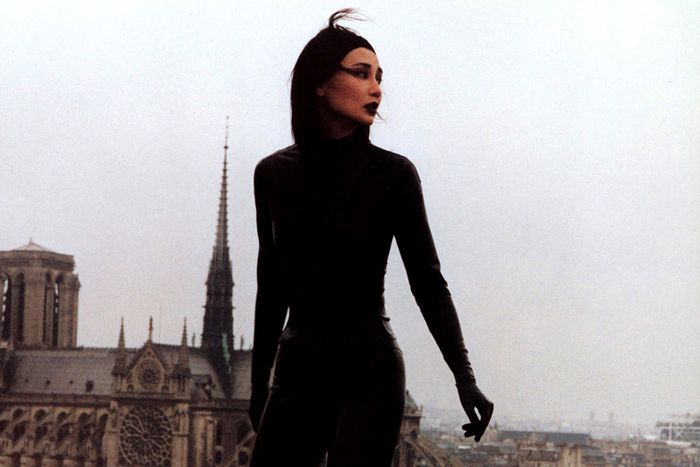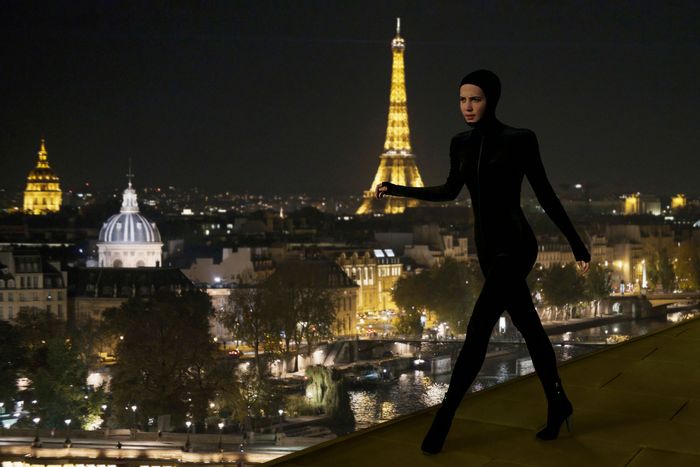
When Maggie Cheung steps into the catsuit in Olivier Assayas’s 1996 film, Irma Vep, the latex seems to glimmer a little harder on her, squeak a bit more rhythmically. The actress, playing a version of herself in a highly self-conscious movie about the art of making movies, takes long, careful strides down a green-carpeted hotel hallway, testing the boundaries of her costume. In the catsuit, a global action star from Hong Kong slowly transforms into the lead of a French film on a threadbare budget — a remake of a real seven-hour silent crime serial from 1916. Mid-fitting, Maggie finds herself wandering into one of the hotel’s rooms, pivoting around a nude woman in a heated phone conversation, darting behind corners, eyes grazing her surroundings, as she slips into the identity of the criminal character she is playing. When she spots a necklace on the bathroom counter, she is overcome with desire — not for riches but for transgression — and so she steals it. Onto the roof and into the cerulean-tinted evening she goes, rain rolling off her lacquered surface, a smile peeking out briefly from behind her veil of jet-black hair.
To inhabit a catsuit onscreen requires gravitas, electricity, an ability to harness tangled notions of transgression and near-sadomasochistic power. Musidora did it with a tinge of haughty confidence, playing the original Irma Vep in silence in Louis Feuillade’s Les Vampires, her first major role. By the time Cheung put on her catsuit eight decades later, she was internationally famous, both in the timeline of Assayas’s movie and in actual life. She had already played the 1930s cinema legend Ruan Lingyu (who died tragically by suicide at age 24) in Center Stage, appeared in popular martial-arts flicks including Johnnie To’s The Heroic Trio, and was a fledgling Wong Kar-wai collaborator. Watching Cheung navigate the balletic possibilities of skintight excessive fashion is to witness a woman in full command of the story her body and costume can tell. In it, she becomes an object of great desire and a person who desires deeply. She becomes aware of how her beauty is exoticized on white film sets and how her “otherness” is viewed. She passes through her world with a mix of light-footedness and dignity, forever shrugging off projections from the people around her, even those directed at her from behind the camera. (Cheung would go on to marry and divorce Assayas, bringing more prickly reality to the role in rewatch, something the 2022 series seizes upon.)
Irma Vep is a series of trapdoors leading to excursions and metatextual riffs. It plays out with a hyperfocused zeal for how the film world cannibalizes its own past, allowing Assayas to comment on the vicissitudes of moviemaking and the industry surrounding the artistry. He was approached in the early 1990s to remake a French classic for television but couldn’t find his way into the story. It was only later, after meeting Cheung and getting invited to make an international co-production alongside Claire Denis and Atom Egoyan, that the image of Irma Vep fluttered to the surface of his mind. “Irma Vep was never a sensible idea,” Assayas has noted. “The project was not devised in terms of production logic. Working conditions were tough, facilities minimal. The budget — with hindsight — seems laughable … All this meant finding ways of working fast, very fast, knowing there was no safety net.” Wild with rapturous editing, drawn-on frames give the film an anarchist edge, cool without outright pretension. But it is Cheung’s performance that fills the film with its significance, the catsuit working to contain her multitudes in a movie overflowing with them.
If the ’96 Irma Vep was lovingly meta, the 2022 series reimagining the movie for TV — also directed and written by Assayas, but this time without Cheung — is overgrown with intertextual discourse. It follows Mira Harberg’s life as an American superstar, played in this version by Swedish actress Alicia Vikander. (It took me several episodes to realize she was playing an American; Vikander’s accent has all the flat vowels and affectations of a newscaster, warped by a European lilt she can’t slip out from under.) She is coming off Doomsday, a superhero epic that notably involves her cutting off the testicles and slitting the throat of her male co-lead, to much acclaim. She moves easily through Vogue photo shoots, swanky Paris premieres, insular after-parties. At one point, she offers a truth to her assistant — the disaffected, fresh-out-of-film-school Regina (Devon Ross) — who the paparazzi muse could be Mira’s new girlfriend. Mira admits she is seen as a star because she fronts luxury brands, “not because I’ve been lucky enough to make a few good films.” Mira is hungry for a challenge, to create what she truly envisions as art. The Les Vampires remake by temperamental director René Vidal (previously played by the real French New Wave legend Jean-Pierre Léaud, now played by director and playwright Vincent Macaigne) is just the right project, involving slinky physicality and a villainous role with more meat to it.
The catsuit reappears in the new series in a familiar fashion. Mira and costume designer Zoe (Jeanne Balibar) are discussing the suit’s design in an ornate studio space filled with glossy surfaces, reams of fabric, and buttermilk-colored walls with delicately painted florals. Mira is at first tentative, noting the fit is a touch too tight. But she is soon archly embracing it. Her steps have a certain insouciance, a drawn-out repose aiming for catlike but falling into overly studied. She traipses up some stairs, slinking silently into the office of an unseen mark before slipping a credit card from their purse. While Maggie’s catsuit glinted, Mira’s is made from a soft dark velvet, absorbing light rather than reflecting it. It’s a slight nod, deliberate or not, at the fact that Vikander’s star burns at a far different temperature than Cheung’s did in 1996. To this point, Vikander has starred in some big-budget movies — The Man from U.N.C.L.E. and the Tomb Raider reboot flops come to mind — but she is more of a drama fixture known for a mutable quality she brings to film (which nabbed her an Oscar). She is at her best in Ex Machina, playing a robot who becomes the object of man’s lust and insecurities. In front of writer-director Alex Garland’s camera, Vikander becomes a black hole for other people’s ideas, consuming them rather than transforming or repelling them. Interestingly, as Mira, Vikander is described as “magnetic,” a word repeated often enough that it feels as if Assayas is trying to convince us of something the camera cannot.
There’s an inherent thrill to seeing a woman decked out in a tight-ass black ensemble, which makes it such a valuable vehicle for storytellers. (Who can forget the fetishistic whirlpool that was Michelle Pfeiffer as Catwoman? Irma Vep remembers, though the 2022 show lumps her in with the sexless machinations of the superhero set, which shows how imprecise this scalpel of a series can be.) A driving force in cinema is the art of looking and the succor that can be found in such an act, and both versions of Irma Vep invite psychoanalytical criticism of audiences’ relationship to voyeurism and auteurism — and how both impulses are often seen as skewing male, even when they’re not.
A homoeroticism between women takes precedence in the new incarnation of Irma Vep, however, offering a canny excursion from the 1996 story. One of the richest lines of inquiry stems from exchanges between Mira and her former lover and assistant turned sexually charged rival, Laurie (Adria Arjona). Is it any wonder that when Laurie visits her ex-paramour on set for an overt demonstration of their new power dynamics, Mira is wearing the catsuit? Stand up. Open your legs — not that wide, Laurie instructs her ex. Here, the catsuit bucks as much against the sexless machinations of Marvel (“She’s not afraid of her femininity,” Mira says of Irma Vep. “Her femininity scares her foes”) as it does the neat rendition of female empowerment that is currently in vogue. But there is something dead to the scene between lovers, more closed-circuit than surging electricity. Vikander’s lust is rendered too pale, and Arjona overcompensates in kind. Scenes such as this make the story feel more lopsided than thrillingly off-balance.
And while Vikander’s Irma Vep is comfortable introducing new complications when it comes to sexuality and gender onscreen, it has curiously and notably retreated from any meaningful discussion of race. The series, like the movie, takes pains to point out how the film world is constricting, narrowly drawn as today’s contemporary studios are to superheroes and virtuous-yet-vacant female protagonists. But without Cheung, Irma Vep loses its crucial and revealing portrayal of othering — and how what we desire onscreen is as politicized as anything else. Moreover, it misses out on the opportunity to comment on how overwhelming a force China is in the film world today, enough so that Hollywood productions might cleanly nix LGBTQ+ characters or moments from run times in order to release in the territory.
Mira’s story isn’t entirely devoid of Maggie, though. Her ghost seems to hang over the series. Assayas superimposes shots of Cheung striding through the hotel, enjoying the lawless thrills of her catsuit, as Mira is going through similar motions. It makes obvious the truth about this revamp: You can’t help but feel Cheung is haunting the entire series. Assayas acknowledges this, to a degree. A plot twist reveals that 2022’s René has done Irma Vep before, with an actress he would go on to marry and who would then divorce him. Cheung has retired from acting, so the figure of “Jade Lee” is played by Vivian Wu. When she appears to René as an actual apparition, he’s on the edge of tears, asking why she hasn’t spoken to him in the decade since their divorce. “I’m extending it into a series,” René counters when Jade asks how he can do such a remake without her. “You don’t want to be an actress anymore. Or maybe you want to be remembered in your prime,” he adds, a line touched with venom despite a wistful look in his eyes. And so the film’s decision to recast and revamp a role inhabited by a Chinese woman with a white European in American drag is explained away. (The Jade Lee character is dismissed by the series as soon as she is conjured, not appearing in either episode five or six.)
This year’s Irma Vep isn’t without its pleasures. In fact, it’s bursting with them: cameras aiming to work as gracefully as a seasoned ballerina, revelatory costume design by Jürgen Doering, a bombastic supporting cast. Every time the show is about to lose me, it raises an eyebrow to Hollywood’s mores and lovingly draws me back in. But Irma Vep lives and dies based on the performance at its center; it’s too crucial to how we examine the work in total for it to be otherwise. Vikander’s Irma Vep and her new velvet may strive to glimmer in our imagination, but a catsuit is only as powerful as the actor who is poured into it. And unfortunately for this new Irma Vep, the catsuit is wearing Vikander, not the other way around.



